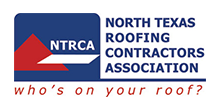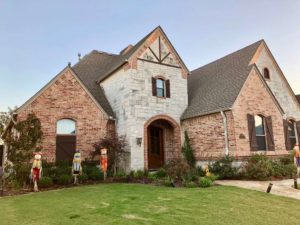Wind and Storm Damage Roof Restoration in Fort Worth, TX
Most people think of Texas as a traditionally hot state, but the reality is that Texas weather is quite varied. From spring thunderstorms to winter ice storms, the state can see some extreme weather events that put Fort Worth homes to the test. One of the most destructive – and unfortunately the most expensive to fix – is wind damage to your roof. To help ensure you understand the facts about Fort Worth roof wind damage, so you know what to do if it happens to your home, here’s what you need to know.
Quick Note
Wind damage to roofs requires careful assessment and professional repairs. Contact a qualified roofing contractor near you to inspect the damage and develop a plan for repairs.
Roof Wind Damage in Fort Worth TX
Fort Worth, TX is prone to strong winds, which can cause extensive damage to roofs. According to the Insurance Council of Texas, a staggering 54% of all property damages due to weather in 2015 were caused by wind. As a result, homeowners should be aware of the potential for roof wind damage and take appropriate steps to mitigate or prevent it.
The best defense against roof wind damage is a strong, well-maintained roof. Regular inspections and maintenance are key in assessing any possible structural weaknesses and addressing any existing issues such as damaged shingles or other parts of the roof. It is also important to check for obstructions such as tree limbs that may hang over the roof and cause additional damage during high winds. This includes ensuring tree branches are trimmed away from the roof as much as possible, as well as removing any debris that may have accumulated on it that could somehow push up against it during high winds.
Sometimes these efforts may not be enough to mitigate or avoid significant roof wind damage in Fort Worth. If this is the case, there are additional measures available such as installing reinforced roof ties at specified intervals using certified storm ties equipped with corrosion-resistant zinc coating or screws with bonding washers. While this method costs more upfront than simply performing regular inspections and maintenance, it can add an extra layer of protection against high winds and ultimately save homeowners considerable amounts of money in repair costs later down the road.
Ultimately, homeowners must make a final decision about how best to approach protecting their roofs from wind damage based on their financial resources and risk tolerance, as well as advice from an experienced contractor.
Evaluation of the Roof Wind Damage
When evaluating your roof after a wind event, it is important to be mindful of both possible superficial and structural damage. Superficial damage may include shingles that have been displaced or cracked. This type of damage can usually be easily fixed and eliminated as a potential source of leakage in the future. On the other hand, structural damage, while not always visible, can present a much larger problem. Wind events can have the potential to knock loose bracing and cause major shifts in the framing and rafter sections of a roof. These types of damages rarely self-repair, and must be addressed by qualified professionals with access to appropriate repair equipment and materials.
It is important to remember that trying to examine for roof wind damage on your own is never recommended due to safety concerns, as well as due to the possibility of missing more serious underlying issues that require professional handling. Professional inspection companies are typically equipped with specialized tools such as infrared cameras which allow them to look beneath the surface layers of material and detect and evaluate hidden components that would otherwise remain inaccessible.
As you assess whether or not a full structural inspection might be necessary after a wind event, keep in mind what type of damage you are seeing on the exterior of the roof. In most cases, if certain minor roof components appear knocked out of place or severely cracked/torn an evaluation by professional technicians might be necessary.
Ultimately, when dealing with roof wind damage it is always wise to err on the side of caution and consult a trained inspector who can provide additional clarity and peace of mind about any issues that might be arising from a weather-related incident. The next section will discuss how best to go about conducting a structural inspection in order to receive an accurate diagnosis of any unseen problems present on your roof.
Most Important Points to Remember
After experiencing a wind event, it is important to be mindful of superficial and structural damage. Superficial damage is usually easy to detect and fix, while structural damage may not be as visible but can cause major shifts in the roof’s framing and rafter sections. It is safest to consult with a trained inspector who will use specialized tools (such as infrared cameras) to look beneath the surface and detect any unseen problems that would remain inaccessible otherwise. When determining if a full structural inspection is necessary, you should consider what type of damage you are seeing on the exterior of the roof. In most cases, superficial damages do not require an official structural inspection.
Conducting a Structural Inspection
When assessing damage to your roof caused by wind, it is important to conduct a thorough structural inspection. A professional inspector should climb onto the roof and examine any areas of the roof clearly affected by wind damage. He or she should be looking for signs of wind damage such as broken shingles, damaged flashing, and missing or displaced tiles. He or she should also check for any obstructions that may be blocking the pull of air underneath the shingles, which can cause them to come loose. Additionally, an inspector should also look at all of the windows and doors on the property, as the wind can enter from these sources and put additional pressure on the roof.
In some cases, if the damage appears minor, it may be possible to simply repair it without having to fully replace the entire roof. While this may save money in the short run, it is important to understand that such repairs will not necessarily last. Therefore, it may be prudent to consider replacing the entire roof when damages become extensive or if major repairs are necessary. Ultimately, it is up to each individual homeowner to decide whether they should repair or replace their damaged roofs based on what budget they have available and how much protection they need from further wind damage.
Having conducted a thorough structural inspection and evaluated all options, homeowners can now move forward with evaluating the degree of damage inflicted upon their roofs. This important step is discussed in more detail in the following section.
Evaluating the Degree of Damage
The extent and degree of the damage your roof has sustained due to wind is the key factor to consider in order to determine whether a repair or replacement is necessary. A visual inspection can provide clues of damage and it is important to take into account the weather conditions that caused the wind event, as well as the age and condition of your Fort Worth home’s roof before the incident occurred.
One potential sign of serious damage that warrants repairs or replacement is if your roof suffered torn shingles, which will be marked by chunks missing from the top layer of material. Similarly, with strong winds come lifted or curled shingles, leading to an increased chance that water will penetrate underneath. It’s also possible for these peeled-back sections of material to be ripped from the underlying sheet and forced onto other portions of the roof, potentially leading to unkempt lines caused by misaligned ridging. These instances are more likely on roofs near the end of their lifespan. Another consequence of strong winds is significant granule loss; with smaller particles blasted away from the surface, it could make it nearly impossible for waterproofing capabilities to be effective without replacing the shingles entirely.
It may be relatively easy to fix minor wind damage such as bent vents or pipes and seal any broke,n flashing around chimneys or edges that have been affected. An overall assessment should review all potential elements, even inspecting inside your attic for further signs of leaks or other complications that a visual inspection might not cover.
Regardless of what is found following a detailed evaluation, understanding the scope and severity of roof wind damage stemming from a severe storm is integral in determining how best to handle repairs or replacement. Being aware of these vulnerabilities will help ensure you make an informed decision when noting changes that need to take place after an inclement weather event.
The next step when evaluating roof wind damage is often addressing any immediate fixes needed in order to preserve stability until further repair or replacement can ensue.
Fixing the Roof Wind Damage
When it comes to fixing the roof wind damage, homeowners have a range of options depending on the severity of the damage. However, it is highly recommended that homeowners contact a professional contractor to inspect and fix the issue.
The major argument for contacting a professional is that they are trained in properly diagnosing and fixing the root cause of any problems, rather than simply covering up the issue. Professional contractors can detect underlying problems deeper within the roof that are not immediately visible and can even detect any sort of water infiltration or trapped moisture which could cause mold growth or other issues down the road. Additionally, professional contractors are typically backed by insurance policies which further provides assurance that no additional troubles will arise after they finish their job.
In conclusion, repairing roof wind damage depends on both personal preference and budget considerations – homeowners should assess their abilities and research their options carefully before making any decisions. No matter how you choose to approach this situation, it’s important to remember to always prioritize safety first for any kind of repair work.
Safety Considerations for Repairing Wind Damage
When it comes to safety considerations for repairing Fort Worth roof wind damage, homeowners should always keep safety as their number one priority. Repairing roof wind damage is a dangerous and challenging task that requires special tools, techniques, and even hazardous materials in some cases. As such, homeowners should be aware of the potential hazards involved and proceed with caution at all times.
Experts highly advise against attempting any repairs or maintenance yourself. Instead, it is much safer to call in a qualified professional or team of professionals who are familiar with repairing roofs after wind damage due to their knowledge and expertise. Additionally, qualified contractors have access to special tools and equipment that can help them carry out the repairs quickly and safely.
Overall, ensuring safety should always come first – regardless of whether you plan to take on the project yourself or seek advice from a professional expert.
Where to Seek Expert Advice
When it comes to Fort Worth roof wind damage, it is important that residents seek expert advice. In order to get the best possible advice, it is important to locate a reputable company that specializes in roofing damage caused by severe weather events. The goal should be to obtain a complete understanding of the scope of the problem and the potential risks involved with any proposed repair or construction projects.
One option for seeking expert advice is to contact a local roofing contractor or building specialist. Highly experienced local contractors typically have extensive knowledge of regional weather conditions, architectural design trends, and regulations pertaining to residential building construction and repairs. This makes them ideal resources for assessing wind damage and available repair options. Furthermore, many contractors are familiar with common insurance companies in the area, making the process of filing a claim much easier.
Another option is to contact your insurance provider directly in order to obtain an estimate on the cost of repairing any existing storm damage. Insurance estimates can provide you with an indication of the severity of existing wind damage as well as what types of repairs may be necessary in order to prevent any future damage from occurring. It is important, however, to remember that insurance will likely only cover damages stemming from external sources such as severely strong winds, hail storms, or other inclement weather events. Therefore, other internal issues associated with Fort Worth roof wind damage may not be covered by your current policy and could require additional out-of-pocket expenses.
In addition, homeowners associations in Fort Worth may also be able to provide their members with valuable guidance and resources related to roof wind damage assessment and repair work. Associations often maintain relationships with local roofing contractors who specialize in storm damage prevention and repairs, making them an ideal resource for obtaining up-to-date information on methods for protecting homes against high winds and other elements.
Finally, Fort Worth residents should also research online resources related to building safety codes, wind resistance standards, and general maintenance best practices. By staying widely informed on these topics, homeowners can gain a comprehensive understanding of all their available options when it comes to addressing both present and future roof wind damages.
Frequently Asked Questions
What types of winds cause the most damage to roofs in Fort Worth, TX?
The most damaging winds to roofs in Fort Worth, TX are typically winds generated by severe thunderstorms and other storms. These winds can be especially damaging if they contain hail, or if the wind gusts reach speeds of 50-60 mph or higher. High winds can cause shingles to tear off, flashings to fail, or entire pieces of the roof structure to come loose. In addition to the physical damage caused by high winds, there is the risk that water will enter through damaged areas and cause further damage from water intrusion. It is always best to inspect a roof after any storm that brings high winds and look for signs of roof damage.
What are the most common signs of wind damage to roofs in Fort Worth, TX?
In Fort Worth, TX, some of the most common signs of wind damage to roofs include:
- Missing or damaged shingles – High winds can easily blow shingles off a roof and cause damage to those that remain. It’s also important to look for any signs of buckling, curling, or blistering–which are all indicators that the shingles have been affected by the wind.
- Damaged flashing – Flashing is installed at the points on your roof where it intersects with walls and chimneys to create an airtight seal. However, high winds can tear away or damage flashing, making it more prone to leaks and water damage.
- Loose gutters and trim – Gutter systems are especially susceptible to wind damage as they’re often not securely fastened to the building structure and clog easily as a result of debris buildup. Wind can move these unattached parts and potentially loosen them over time. Likewise, trim around the edges of your roof should be closely inspected for signs of weathering caused by wind-born debris or strong gusts.
- Blocked drains and valleys – Drains and valleys that have become blocked by leaves, dirt, and other debris can prevent water from safely draining away from your roof and put added strain on its structural integrity. In severe cases, excessive water pooling could lead to leaks or even collapse when exposed to powerful winds.
What can be done to prevent wind damage to roofs in Fort Worth, TX?
The best way to prevent wind damage to roofs in Fort Worth, TX is by investing in a good quality roofing system. This includes installing high-grade shingles, strengthening weak spots with hurricane straps, and ensuring that all your flashing and ventilation systems are up to code. All of these elements work together to reduce wind pressure on your roof and make it more resistant to damage caused by high winds. Other important elements include making sure your gutters are properly installed and maintained, keeping trees and vegetation close to the house trimmed back, and having professional inspections done regularly. Taking these steps now could potentially save you thousands of dollars down the road.










